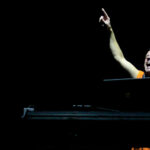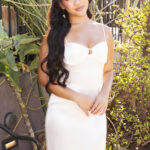Picture the vibrant nightlife of 1940s San Francisco. Imagine stepping into a glamorous nightclub, the air buzzing with anticipation for the floorshow. A dancer in sequins executes a delicate pas de bourrée, while her tuxedoed partner captivates the crowd with impressive splits. The soulful voice of a blues singer fills the room with “Some of These Days.” And then, a nude dancer gracefully appears, wielding enormous feather fans. In this dazzling scene, what would be the likelihood of any of these performers being Asian-American?
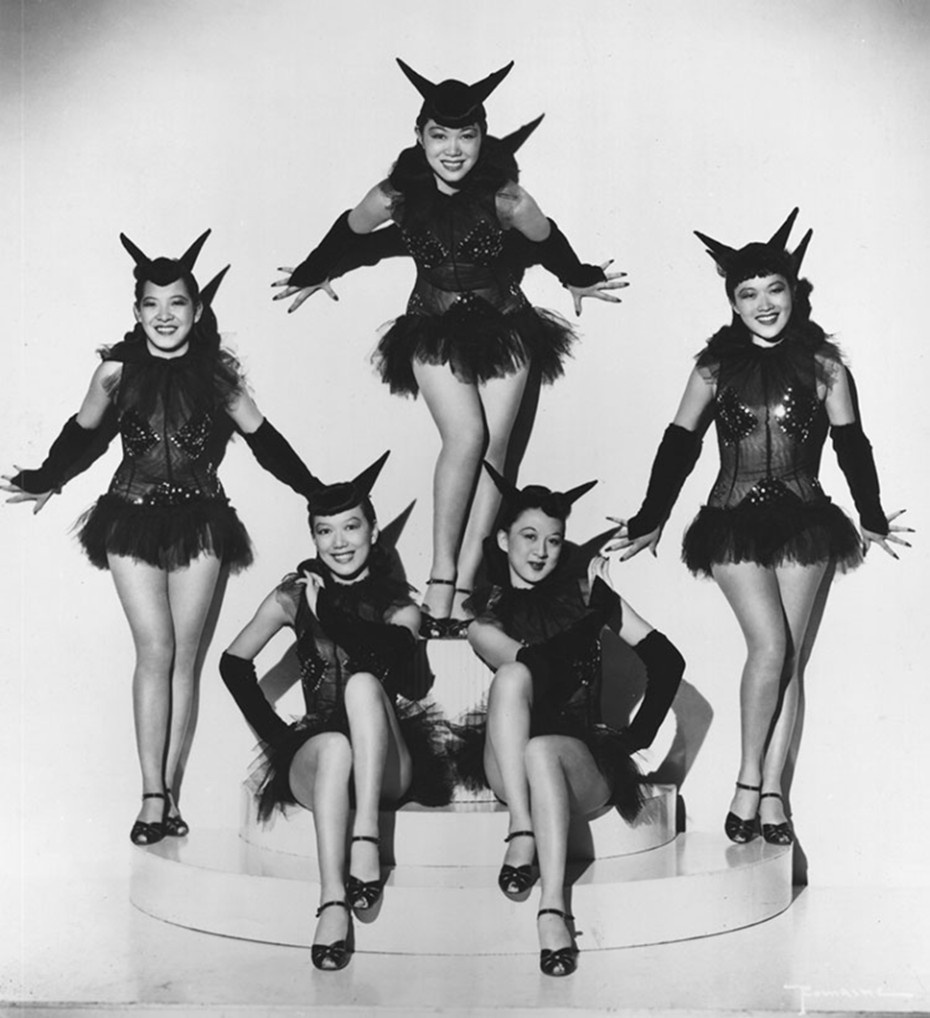 The Forbidden City chorus girls known as the "Devilettes" in a vintage photograph, showcasing their glamorous attire and poised stances, identified from left to right as Mary Ong, Lily Pon, Bertha Hing, Dottie Sun, and Mary Mammon, reflecting the diversity and talent of Asian American performers in the 1940s nightclub scene.
The Forbidden City chorus girls known as the "Devilettes" in a vintage photograph, showcasing their glamorous attire and poised stances, identified from left to right as Mary Ong, Lily Pon, Bertha Hing, Dottie Sun, and Mary Mammon, reflecting the diversity and talent of Asian American performers in the 1940s nightclub scene.
For two decades, San Francisco’s Chinatown nightclubs shattered stereotypes, proving that Chinese-Americans were not confined to outdated perceptions of cooks and launderers from a mystical, distant land. They were sophisticated individuals with style and rhythm, ready to “cut a rug” – and not just an Oriental one. In its prime, San Francisco boasted six nightclubs featuring all-Asian floorshows, intentionally named to evoke exoticism and attract a predominantly white clientele. Names like The Dragon’s Lair, The Lion’s Den, Kubla Khan, The Chinese Sky Room, and Club Shanghai set the stage, but the most legendary of them all was Forbidden City.
The visionary behind Forbidden City was Charlie Low, who arrived in San Francisco from Nevada in 1922. During the Roaring Twenties, Low’s ambition led him to persuade a brokerage firm to establish a Chinatown office, placing him in charge. Facing racial discrimination in 1927 when landlords refused to rent to his family, Low demonstrated his resilience by assisting his mother in constructing the first modern apartment building in Chinatown. Low’s passion for nightlife eventually led him to the bar industry after Prohibition. In 1936, he launched Chinese Village, Chinatown’s pioneering cocktail bar.
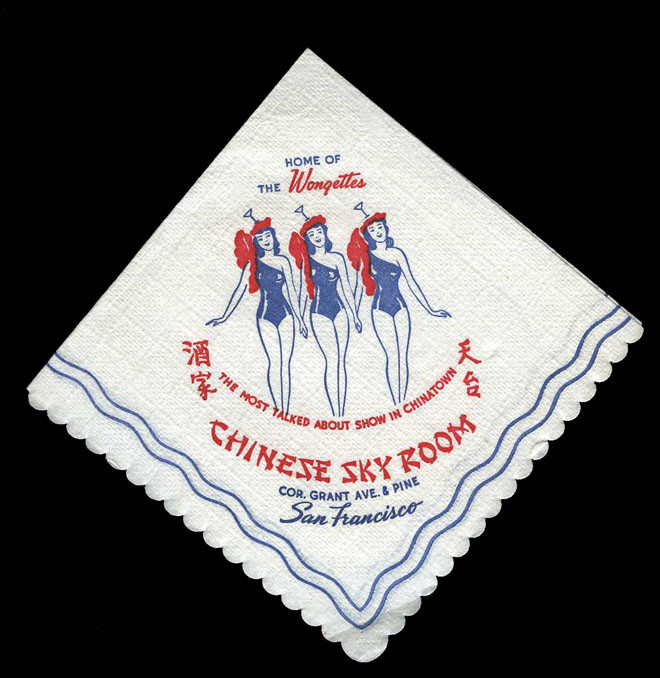 A vintage photograph capturing Andy Wong's Chinese Sky Room in San Francisco's Chinatown, circa 1950, showcasing a glimpse into the vibrant nightlife and entertainment venues of the era, sourced from Flickr.
A vintage photograph capturing Andy Wong's Chinese Sky Room in San Francisco's Chinatown, circa 1950, showcasing a glimpse into the vibrant nightlife and entertainment venues of the era, sourced from Flickr.
The following year, just a short distance down Grant Street, Andy Wong, a trumpet player, inaugurated the Chinese Sky Room, the first Chinese-American nightclub. Wong, who had honed his musical skills playing in funeral bands in San Francisco before joining the jazz sextet Chinatown Knights, envisioned a sophisticated nightclub like those he saw in films. He wanted a place where his band could perform for glamorous couples dancing the night away.
 A 1942 photograph of Mai Tai Sing dancing gracefully with her husband, Wilbur Tai Sing, at the Forbidden City nightclub, capturing the elegance and artistry of the club's performers during its heyday.
A 1942 photograph of Mai Tai Sing dancing gracefully with her husband, Wilbur Tai Sing, at the Forbidden City nightclub, capturing the elegance and artistry of the club's performers during its heyday.
While Low’s cocktail bar was successful, he felt a sense of “FOMO” observing Wong’s venture. Believing he could create something even better, particularly with his talented wife, Li Tei Ming, a captivating torch singer, by his side, Low took action. Securing a location near Chinatown and decorating it with Chinese artifacts, he opened Forbidden City in 1938. Despite initial concerns about finding performers, Low recalled, “I thought I would have a lot of trouble in recruiting a good Chinese floorshow, but I was quite lucky.”
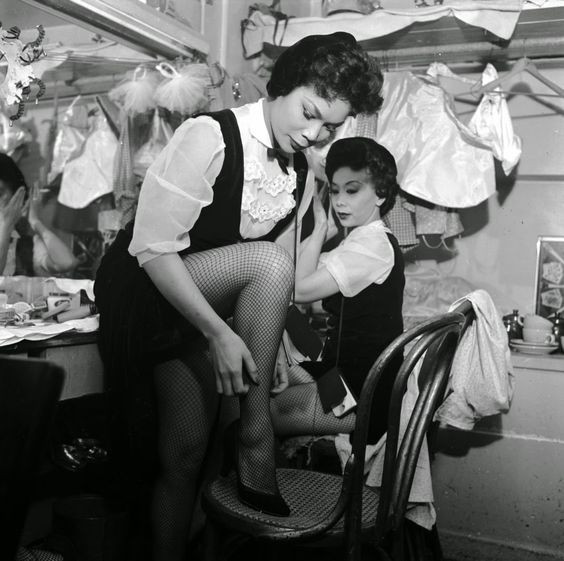 A behind-the-scenes shot of two chorus girls at the Forbidden City nightclub preparing for their performance, highlighting the anticipation and energy before taking the stage and showcasing the dedication of the performers.
A behind-the-scenes shot of two chorus girls at the Forbidden City nightclub preparing for their performance, highlighting the anticipation and energy before taking the stage and showcasing the dedication of the performers.
Low discovered his talent pool among the numerous young Asian-Americans who had migrated to the city in search of opportunities. Born and raised in America, they had grown up immersed in Hollywood musicals and the sounds of jazz on the radio. However, their parents, first-generation Asian immigrants who had navigated the challenges of the Chinese Exclusion Act, often held traditional views and were less supportive of artistic careers. Consequently, many Forbidden City performers lacked formal training in music or dance. By choosing show business, they were boldly challenging the expectations of both their Asian-American families and the predominantly white society. For the women, this career path represented an additional layer of defiance against patriarchal norms of modesty and decorum.
Ellen Chinn, the headliner on opening night, was a teenage runaway from Monterey with a few years of dance experience before joining Forbidden City. Many chorus girls, including Dottie Sun, Mary Mammon, and Mai Tai Sing, initially worked as cocktail waitresses while honing their dance skills under the guidance of Forbidden City choreographer Walton Biggerstaff, whose studio became a hub for emerging Chinatown nightclub talent.
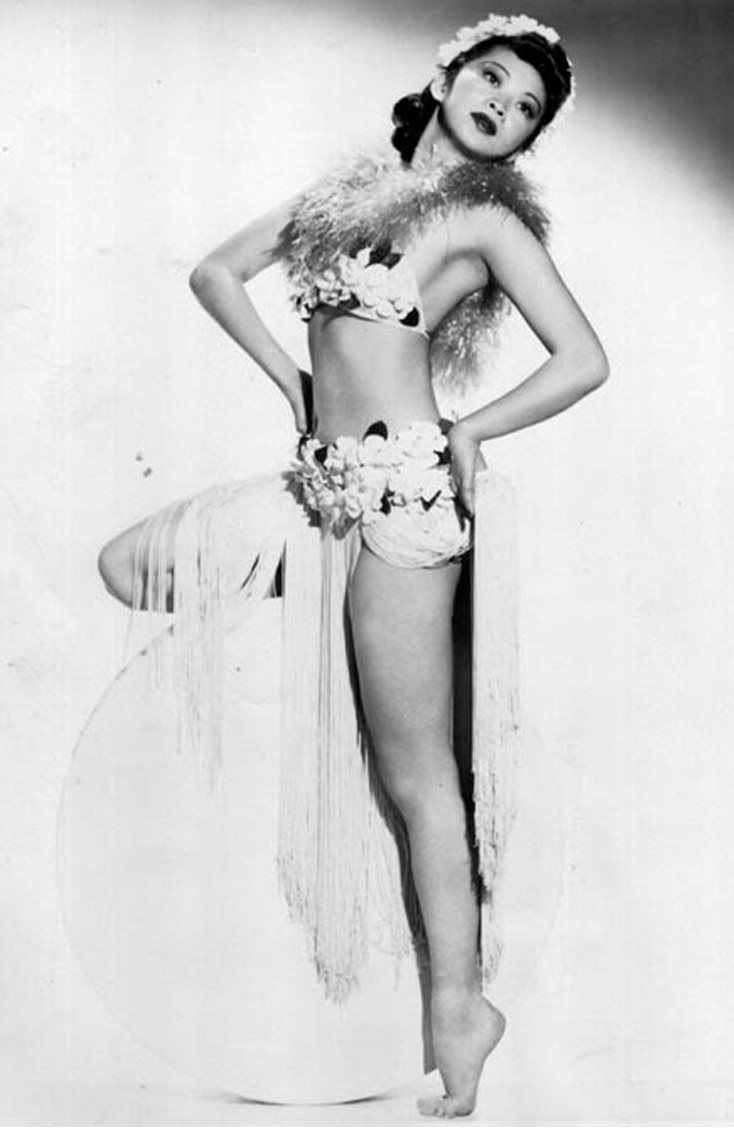 Ellen Chinn, known as the "Chinese Betty Grable," in a publicity shot, emphasizing her glamorous persona and the nickname that highlighted her contemporary appeal and recognition in the entertainment scene.
Ellen Chinn, known as the "Chinese Betty Grable," in a publicity shot, emphasizing her glamorous persona and the nickname that highlighted her contemporary appeal and recognition in the entertainment scene.
 A collection of "Glamour Girls" from a Forbidden City souvenir program, displaying the striking beauty and diverse looks of the performers, indicative of the nightclub's allure and the celebration of Asian American beauty in the 1940s.
A collection of "Glamour Girls" from a Forbidden City souvenir program, displaying the striking beauty and diverse looks of the performers, indicative of the nightclub's allure and the celebration of Asian American beauty in the 1940s.
Another opening night star was Jadin Wong, one of the few performers with formal dance training. Wong’s passion for dance was undeniable, and she funded her own lessons from a young age. Running away to Hollywood in pursuit of fame, she faced hardship and poverty. In a desperate attempt to earn money for food, she decided to tap dance on Hollywood Boulevard. Serendipitously, director Norman Foster happened to pass by. He invited her to lunch and introduced her to his wife, the renowned movie star Claudette Colbert. This chance encounter led to Wong’s role in Mr. Moto Takes a Vacation, a film starring Peter Lorre in yellowface. A year later, following a dance teacher to San Francisco, she found her way to Forbidden City.
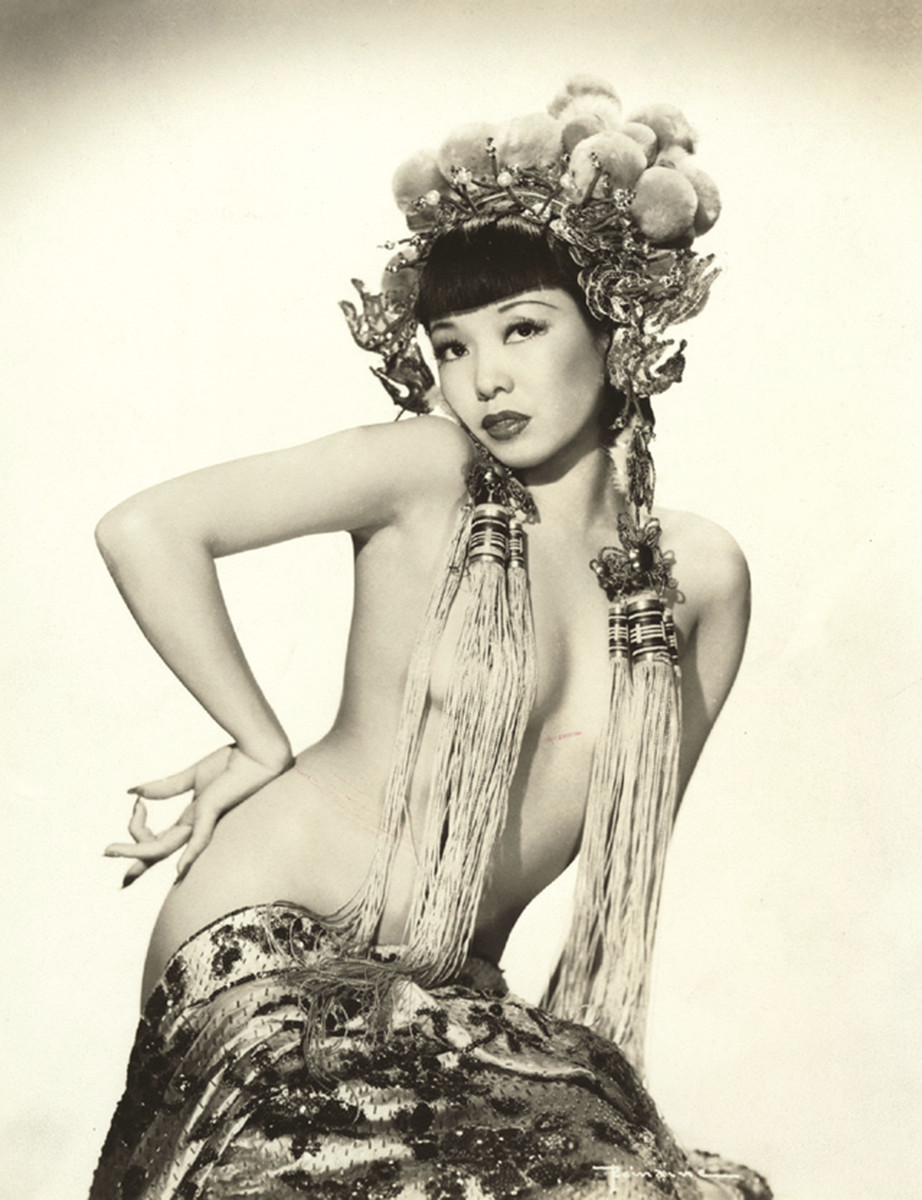 Burlesque dancer Jadin Wong, captured in a 1940 photograph, highlighting her captivating stage presence and the emerging burlesque scene within Asian American nightclubs during that era.
Burlesque dancer Jadin Wong, captured in a 1940 photograph, highlighting her captivating stage presence and the emerging burlesque scene within Asian American nightclubs during that era.
 A stunning 1941 portrait of Jadin Wong, preserved by the Museum of the Chinese in the Americas, showcasing her beauty and elegance as a prominent figure in the Forbidden City nightclub and the broader Asian American entertainment landscape.
A stunning 1941 portrait of Jadin Wong, preserved by the Museum of the Chinese in the Americas, showcasing her beauty and elegance as a prominent figure in the Forbidden City nightclub and the broader Asian American entertainment landscape.
Larry Ching joined the merchant marines in 1937 at 17 and honed his singing skills listening to records on ships. After leaving the marines, he started as a waiter at Charlie Low’s Chinese Village, refining his performance abilities while serving customers. With his charm and smooth demeanor, Ching became known as the “Chinese Frank Sinatra.” However, Ching admitted, “I always hated that handle. I liked ‘Bing Crosby’ much better. But I really wished I could just be ‘Larry Ching.’” San Francisco Chronicle columnist Herb Caen famously quipped, “Frank Sinatra is really the Italian Larry Ching.”
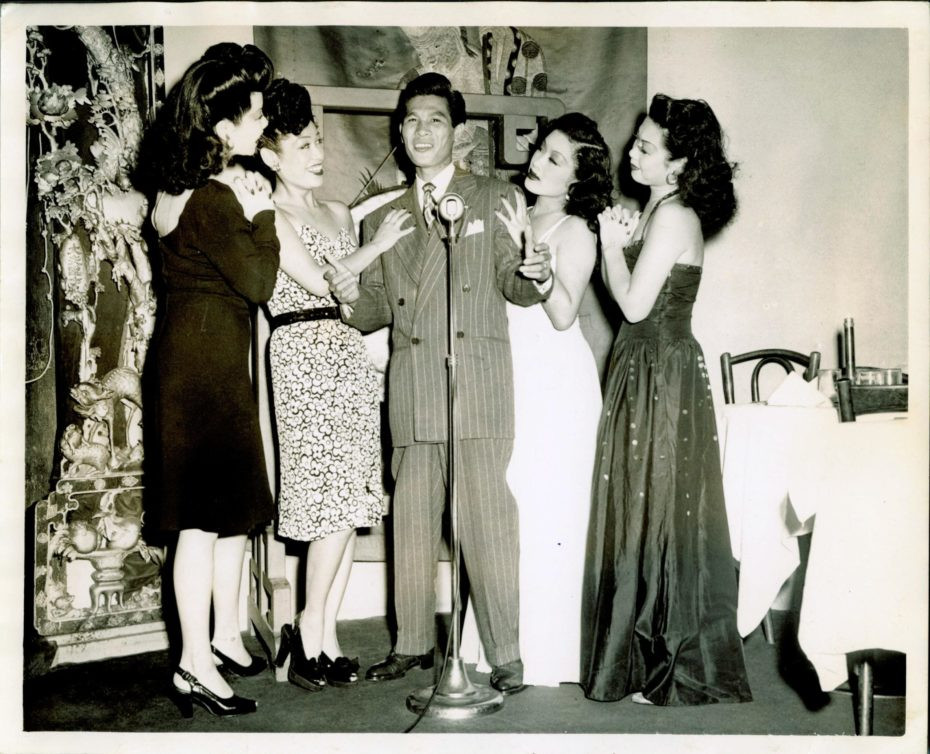 A photo of Larry Ching, described as a "babe magnet," surrounded by Forbidden City ladies, including (from left to right) Mai Tai Sing, Jade Ling, Diane Shinn, and Betty Wong (Charlie Low's third wife), taken in the early 1940s, courtesy of DeepFocus Productions Inc., capturing the nightclub's vibrant social scene and the performers' popularity.
A photo of Larry Ching, described as a "babe magnet," surrounded by Forbidden City ladies, including (from left to right) Mai Tai Sing, Jade Ling, Diane Shinn, and Betty Wong (Charlie Low's third wife), taken in the early 1940s, courtesy of DeepFocus Productions Inc., capturing the nightclub's vibrant social scene and the performers' popularity.
Forbidden City patrons could choose between Chinese or American cuisine, complemented by an extensive cocktail menu. Three nightly shows, each lasting about 45 minutes, featured singers, dancers, and variety acts. Typically, the floorshow commenced with a chorus line of women in imitation Asian robes, bowing and shuffling to the sounds of gongs and flutes. These “Orientalia” costumes were quickly shed to reveal dazzling, leg-baring outfits. From that point on, the show was entirely American in style. The exotic East served as an initial lure for the largely white audience, but the Asian-American performers consciously resisted perpetuating stereotypes. Singers performed contemporary hits, and dancers showcased jazz, rumba, and mambo. Burlesque performers, while often adorned in exotic costumes, delivered the same bump-and-grind routines as their white and Black counterparts.
 Noel Toy, recognized as the "Chinese Sally Rand," in a publicity image that draws a direct comparison to the famous fan dancer, highlighting Toy's unique adaptation of burlesque and her impact on the nightclub's popularity.
Noel Toy, recognized as the "Chinese Sally Rand," in a publicity image that draws a direct comparison to the famous fan dancer, highlighting Toy's unique adaptation of burlesque and her impact on the nightclub's popularity.
Initially, business was slow, and Charlie Low struggled to meet payroll. Publicist Bill Steele suggested Low hire a Chinese girl to emulate burlesque dancer Sally Rand, who was attracting massive crowds with her “Nude Ranch” at the 1939 World’s Fair in San Francisco. Low was uncertain how to find an Asian-American woman willing to perform nude burlesque, but then he encountered Noel Toy, a Chinese-American college student. Toy was working at “Candid Camera,” another risqué World’s Fair attraction, earning $35 weekly posing nude for amateur photos.
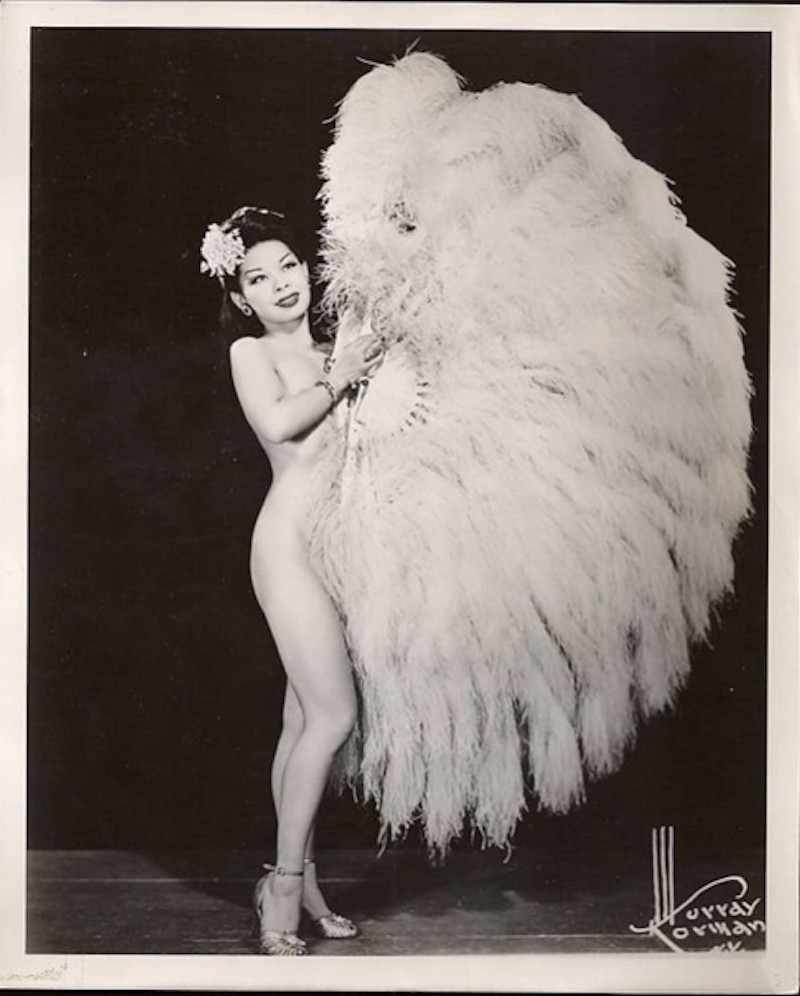 A photograph of Noel Toy taken by Murray Norman, capturing her allure and poise, and contributing to her image as a burlesque dancer who brought a unique Asian American flair to the art form during the Forbidden City era.
A photograph of Noel Toy taken by Murray Norman, capturing her allure and poise, and contributing to her image as a burlesque dancer who brought a unique Asian American flair to the art form during the Forbidden City era.
Toy accepted Low’s offer of $50 per week to perform at his club, using a large balloon as her only prop. Billed as the “Chinese Sally Rand,” suggestive advertisements posed the question, “Is it true what they say about Chinese girls?”. Business surged as white patrons, intrigued by rumors and stereotypes surrounding Asian women and “Chinese-girls-naked-dancing”, flocked to Forbidden City. Noel Toy responded to the racist and misogynistic undertones with humor, quipping about the lurid question, “Oh sure, it’s just like eating corn on the cob!”
 Jadin Wong at Forbidden City in a 1930s photograph, dressed in an exotic costume, showcasing her early performances and the nightclub's blend of cultural elements and burlesque entertainment that attracted diverse audiences.
Jadin Wong at Forbidden City in a 1930s photograph, dressed in an exotic costume, showcasing her early performances and the nightclub's blend of cultural elements and burlesque entertainment that attracted diverse audiences.
A pivotal moment arrived with a four-page photo essay in Life Magazine on December 9, 1940. The spread declared Forbidden City “the No. 1 all-Chinese night club in the U.S.” and featured striking photographs of Jadin Wong in an exotic costume, Li Tei Ming singing, and a chorus line of Asian-American women in rumba outfits. Life Magazine asserted, “Chinese girls have an extraordinary aptitude for Western dance forms. As singers, not many achieve success according to occidental standards. But slim of body, trim of leg, they dance to any tempo with a fragile charm distinctive to their race.”
 The iconic photo of Forbidden City chorus girls featured in Life Magazine in 1940, capturing their synchronized movements and glamorous attire, which significantly boosted the nightclub's popularity and recognition.
The iconic photo of Forbidden City chorus girls featured in Life Magazine in 1940, capturing their synchronized movements and glamorous attire, which significantly boosted the nightclub's popularity and recognition.
 A cover of Beauty Parade Magazine from November 1943 featuring Forbidden City, indicating the nightclub's growing fame and its representation in popular media, further amplifying its allure and drawing wider audiences.
A cover of Beauty Parade Magazine from November 1943 featuring Forbidden City, indicating the nightclub's growing fame and its representation in popular media, further amplifying its allure and drawing wider audiences.
Following the Life Magazine feature, numerous publications highlighted Forbidden City, including Beauty Parade Magazine in 1943. Business tripled after the article and then quadrupled after the U.S. entered World War II in 1941. San Francisco became a hub for servicemen and shipbuilding workers, all drawn to the exotic Chinatown nightclubs. Celebrities like Errol Flynn, Ethel Waters, Ronald Reagan, Bing Crosby, Duke Ellington, and Frank Sinatra became regulars. Grey Line Tours even scheduled five busloads of tourists per show.
 Jadin Wong pictured with Humphrey Bogart and Lauren Bacall, capturing a moment of celebrity mingling at Forbidden City and highlighting the nightclub's appeal to a wide range of clientele, including Hollywood stars.
Jadin Wong pictured with Humphrey Bogart and Lauren Bacall, capturing a moment of celebrity mingling at Forbidden City and highlighting the nightclub's appeal to a wide range of clientele, including Hollywood stars.
The booming business led to the emergence of other Chinese-themed nightclubs, creating more opportunities for Asian-American entertainers. This circuit became known as the “chop suey circuit.” In New York City, a white producer opened the China Doll, featuring revues with racially insensitive names like “Slant Eyed Scandals.” A club also opened in Washington, D.C. San Francisco eventually hosted six such clubs, all Asian-owned and primarily in Chinatown. Eddie Ponds opened the Dragon’s Lair and then Kubla Khan, a lavish two-story venue where he famously played maracas with the Latin house band. When wealthy Chinese herbalist Fong Wan acquired Club Shanghai in 1946, he and Charlie Low became renowned rivals. In 1949, Wan sued Low for $50,000 for allegedly poaching an acrobat from Club Shanghai. Wan even bought a building solely to erect a giant neon sign diverting patrons from Forbidden City to his club.
 A vintage sign for Club Shanghai, capturing the aesthetic of the era's nightclub signage and representing the competitive nightlife scene in Chinatown, where clubs like Forbidden City and Club Shanghai vied for popularity.
A vintage sign for Club Shanghai, capturing the aesthetic of the era's nightclub signage and representing the competitive nightlife scene in Chinatown, where clubs like Forbidden City and Club Shanghai vied for popularity.
Asian-American performers were highly sought after during World War II, touring for the U.S.O., Stage Door Canteen, and Red Cross. Jadin Wong reportedly parachuted into Germany and secretly traveled through the Black Forest to perform with Bob Hope at a secret army base. While facing dangers in Europe, Asian-American performers also encountered segregation in the American South. Singer Frances Chun recalled, “I went to the Ladies Room, and I saw a sign that said Black and a sign that said White. So I stood there and I said now where should I go? Where do I belong?” Dancer Jackie Mei Ling remembered being asked at a diner in Louisville, “I have to ask you a terribly pertinent question: ‘Are you people black?’” Although they did not face the same level of hostility as Black performers, they were not fully accepted either.
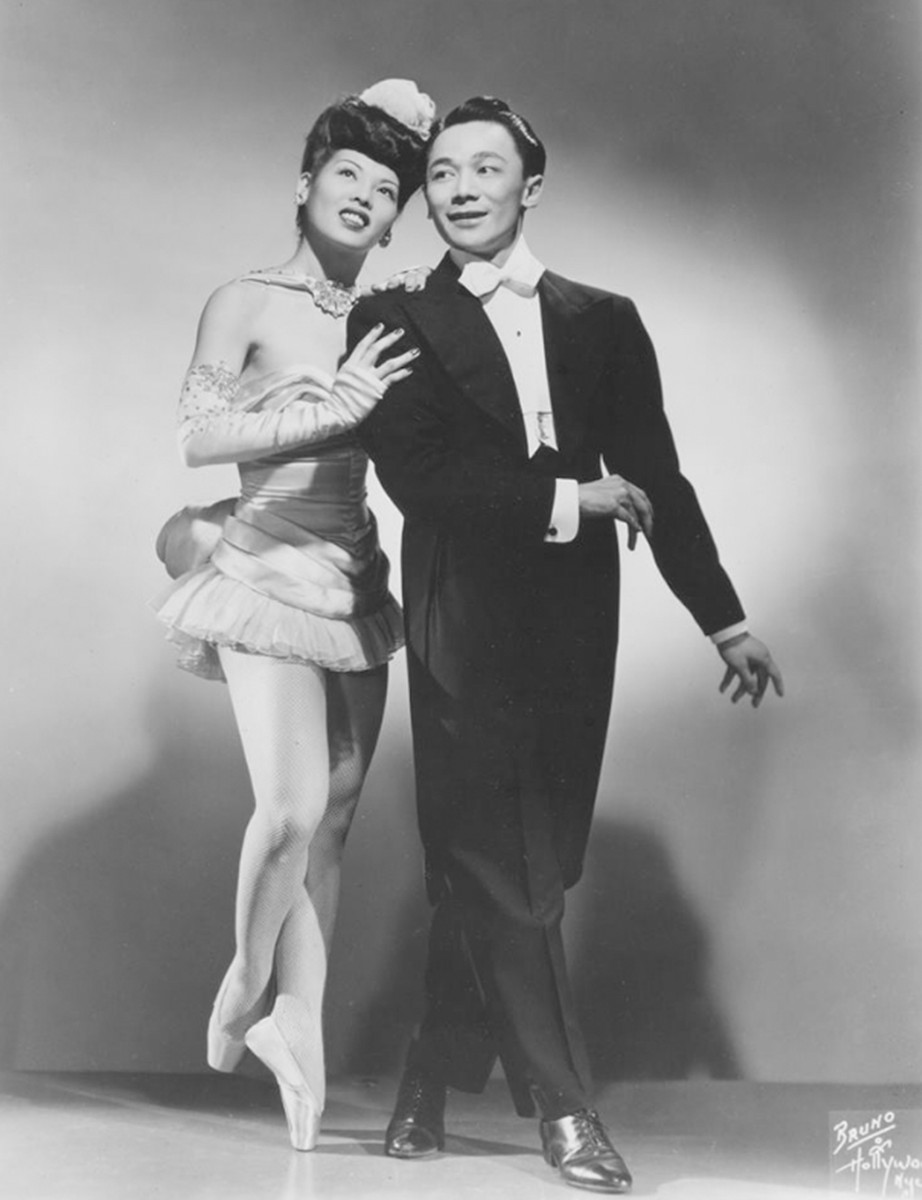 Dorothy Toy and Paul Wing, a celebrated Asian American dance duo, in a promotional shot, highlighting their partnership and the significant contributions of Asian Americans to dance and entertainment during the mid-20th century.
Dorothy Toy and Paul Wing, a celebrated Asian American dance duo, in a promotional shot, highlighting their partnership and the significant contributions of Asian Americans to dance and entertainment during the mid-20th century.
The dance duo Toy and Wing, among the top Asian-American acts in the U.S., faced unique challenges. Dorothy Toy’s athletic toe dancing and Paul Wing’s acrobatic splits had gained them recognition in Hollywood and on the RKO circuit. However, just before a scheduled appearance in a Marx Brothers film in 1942, Ed Sullivan mistakenly identified Wing as Japanese. In reality, it was Toy, who had changed her surname from Takahashi because she felt it was too long. To avoid Toy being sent to a detention camp, they relocated to Chicago and performed in smaller nightclubs. After Wing was drafted in 1943, Toy continued performing with her sister, but her parents were interned in a Utah detention camp.
 Dancer Jade Ling, in a glamorous photo, noted for her talent and an alleged romantic connection with Orson Welles before his relationship with Rita Hayworth, adding to the intriguing personal stories within the Forbidden City narrative.
Dancer Jade Ling, in a glamorous photo, noted for her talent and an alleged romantic connection with Orson Welles before his relationship with Rita Hayworth, adding to the intriguing personal stories within the Forbidden City narrative.
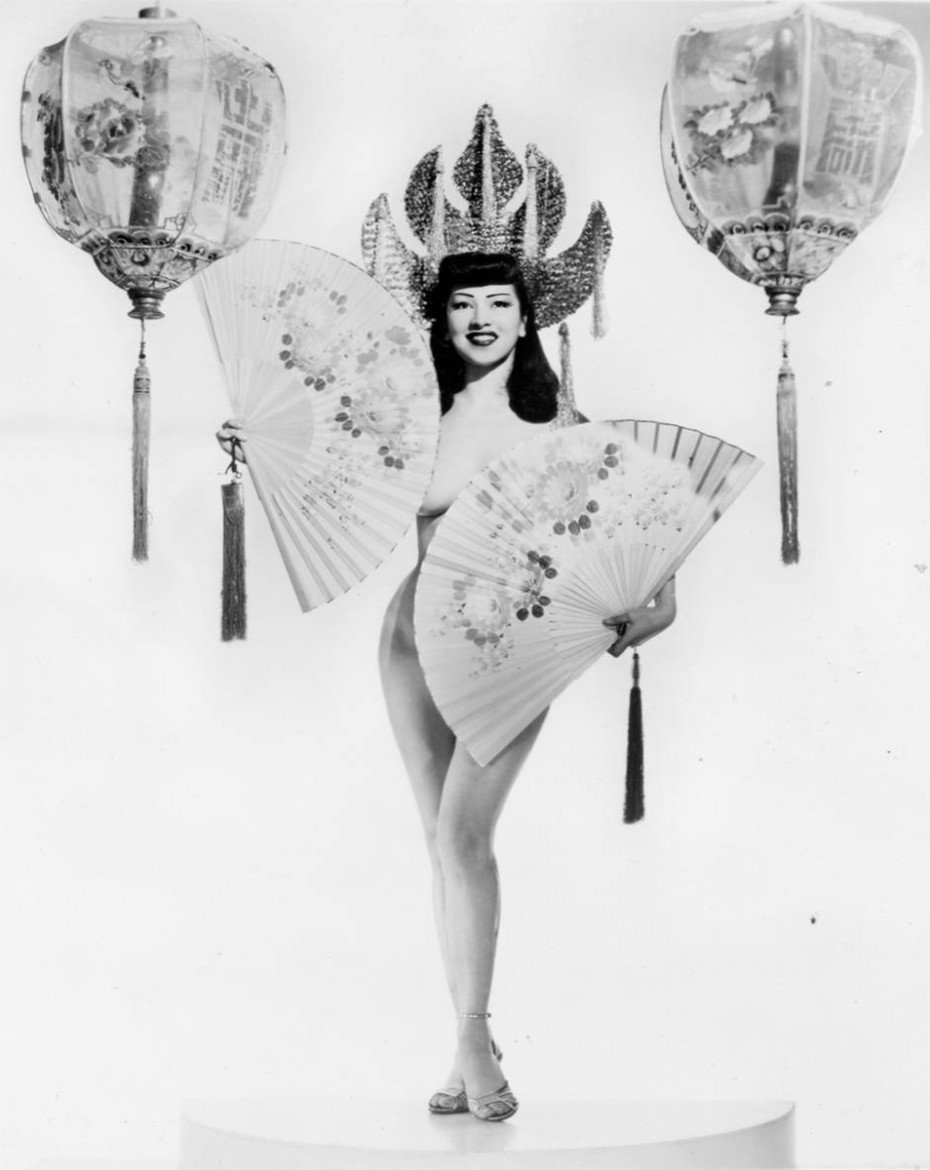 Barbara Yung, a leading burlesque performer of the 1940s, pictured amidst lanterns, representing her performances at Club Shanghai and Kubla Khan and showcasing the prominent roles women played in the Asian American nightclub scene.
Barbara Yung, a leading burlesque performer of the 1940s, pictured amidst lanterns, representing her performances at Club Shanghai and Kubla Khan and showcasing the prominent roles women played in the Asian American nightclub scene.
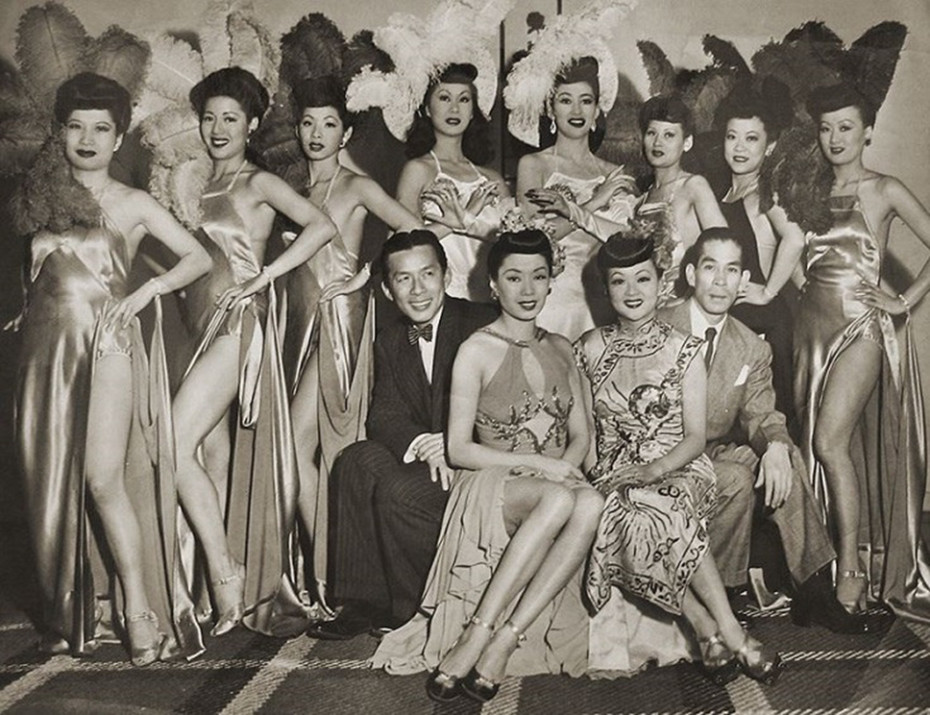 Kubla Khan performers in 1950, with owner Eddie Pond seated on the right in a light suit, capturing a moment of camaraderie and performance culture just before the club's closure, reflecting the changing times for Chinatown nightclubs.
Kubla Khan performers in 1950, with owner Eddie Pond seated on the right in a light suit, capturing a moment of camaraderie and performance culture just before the club's closure, reflecting the changing times for Chinatown nightclubs.
Post-war, the novelty of Chinese-American nightclubs began to diminish, though interest remained sufficient for C.Y. Lee to set part of his 1957 bestselling novel Flower Drum Song at Forbidden City. Flower Drum Song became a successful Broadway musical by Rodgers and Hammerstein, and later a film that won an Academy Award in 1961.
Charlie Low retired in 1962, selling Forbidden City to Coby Yee, a dynamic headliner since the 1940s. However, business continued to decline. The decisive blow came in 1964 when Carol Doda began topless dancing at the Condor Club in North Beach. The rise of topless and nude dancing rendered burlesque and variety clubs outdated. Forbidden City finally closed its doors in 1970.
 Coby Yee, known as the "Chinese Dancing Doll," in a late 1950s photograph, courtesy of Shari Matsuura, highlighting her enduring career and her role in taking over Forbidden City from Charlie Low, continuing its legacy into the changing entertainment landscape.
Coby Yee, known as the "Chinese Dancing Doll," in a late 1950s photograph, courtesy of Shari Matsuura, highlighting her enduring career and her role in taking over Forbidden City from Charlie Low, continuing its legacy into the changing entertainment landscape.
 Toy and Wing reunited and dancing at the Chinese Sky Room in the 1960s, showcasing their lasting partnership and adaptability as they continued to perform in a shifting entertainment industry, maintaining their presence in the nightclub scene.
Toy and Wing reunited and dancing at the Chinese Sky Room in the 1960s, showcasing their lasting partnership and adaptability as they continued to perform in a shifting entertainment industry, maintaining their presence in the nightclub scene.
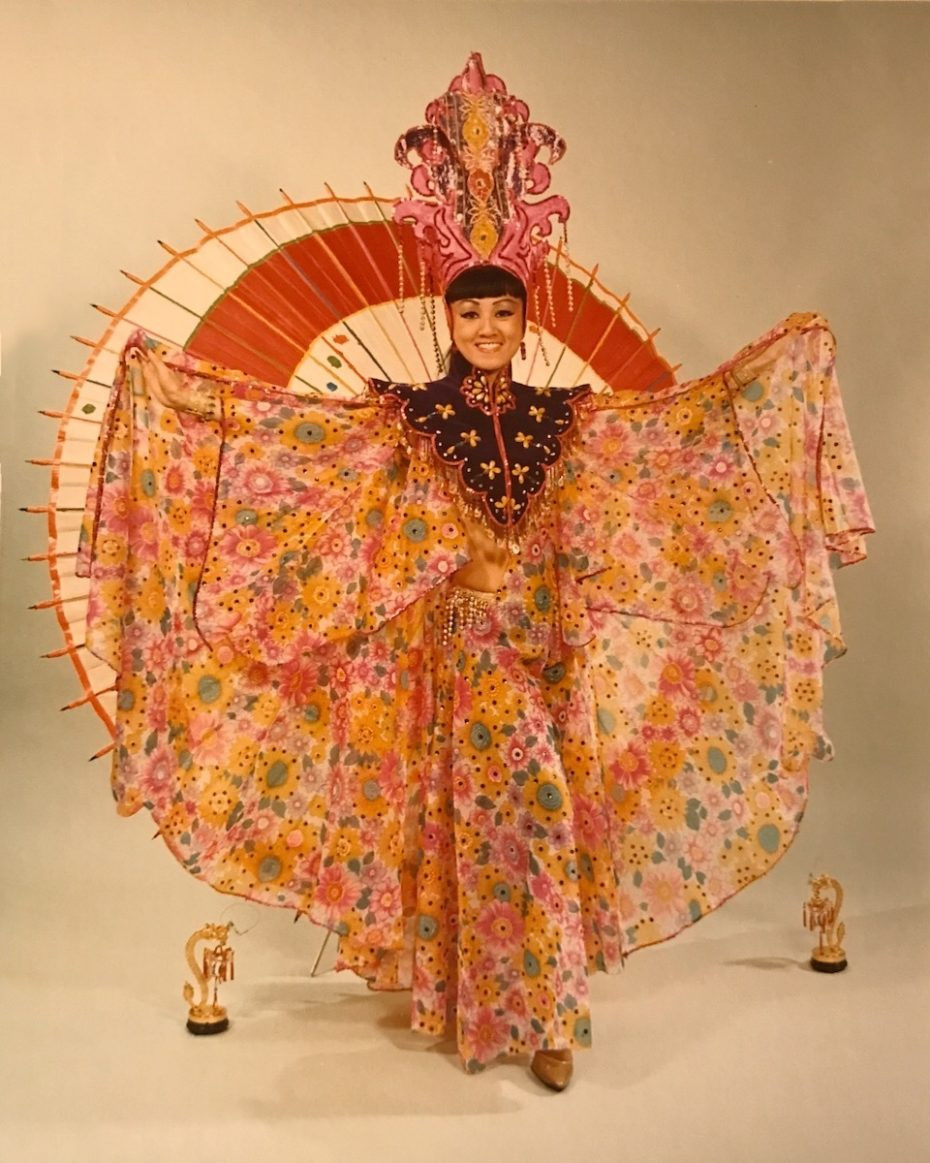 Coby Yee in a striking costume she designed, photographed in the 1960s or 70s, demonstrating her creativity and continued involvement in performance and costume design even as nightclub entertainment evolved.
Coby Yee in a striking costume she designed, photographed in the 1960s or 70s, demonstrating her creativity and continued involvement in performance and costume design even as nightclub entertainment evolved.
Many performers from the Chinatown nightclub circuit transitioned to Hollywood films, Broadway, and television, but mainstream success remained elusive. Due to the prevailing racism, they were consistently perceived as “other” and faced disheartening remarks like, “If it were not for their race, they would undoubtedly be headliners in New York’s Rainbow Room or some other first-line cabaret,” as noted by the Vancouver Herald after Jadin Wong performed with Liang.
Most performers moved on to different careers after the chop suey circuit faded. Larry Ching became a truck driver, and Noel Toy entered real estate. Many women retired to raise families. A few remained in show business, including ballroom dancer Mai Tai Sing, who owned a San Francisco nightclub, and Jadin Wong, who became a manager for Asian-American talent.
 A backstage scene at Forbidden City, captured in a 1948 photograph by Holiday Magazine, offering a rare glimpse behind the glamour and performances, revealing the community and preparations that went into the nightclub's shows.
A backstage scene at Forbidden City, captured in a 1948 photograph by Holiday Magazine, offering a rare glimpse behind the glamour and performances, revealing the community and preparations that went into the nightclub's shows.
Despite catering to a white audience’s fascination with the exotic, Chinatown nightclubs provided a crucial platform for a first generation of Asian-American entertainers. They demonstrated to the world that they were more than just stereotypes. Decades later, these captivating images of beautiful Asian-American faces in elegant gowns and tuxedos offer a poignant glimpse into a brief era when these talented performers were able to truly shine, challenging perceptions and making their mark on American entertainment history, even within the complex dynamics of race, representation, and the evolving landscape of burlesque and “chinese-girls-naked-dancing”.
About the Contributor
Born to a Taiwanese family in NYC’s Lower East Side, Victoria Linchong grew up with a natural instinct to investigate obscure history and secret places. Her mission in life is to rewrite Western history to include women and people of color, after which she will retire to an alpaca farm with a hundred stray cats. As burlesque performer Viva Lamore, she performs internationally and hosts historical web series in vintage drag.

